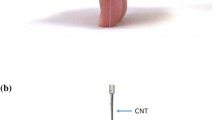Abstract
To improve skin condition, it is considered to be important to make good blood circulation in the epidermis and papillary dermis. In Japan, acupuncture becomes more and more popular to improve facial skin condition. We have been used to one of the traditional Japanese acupuncture methods, Tohokai method, especially Contact Needle Therapy (CNT), for various diseases. The purpose of this study is to investigate the effect of CNT by evaluating changes in blood flow. The skin of four healthy males who have no scratches or disease on the skin of the measurement part (inner forearm) were measured with Optical Coherence Tomography (OCT) before CNT, during CNT, immediately after CNT, and one minute after CNT. OCT is an imaging technique that uses low-coherence light to capture micrometer-resolution, two- and three-dimensional images from within optical scattering media (e.g., biological tissue). CNT consists of a root intervention according to the meridian theory and branch intervention for local effects. Statistical analyses were performed using two-sample paired t test and Wilcoxon Signed-rank test. OCT blood flow signal (150–500 μm) was gradually increased during CNT, and significantly increased immediately after CNT compared with that before treatment (P < 0.05). When comparing the time course of OCT blood flow signal by depth, blood flow increased significantly at 300–350 μm compared to that before treatment (P < 0.05). This is the first study to evaluate the effect of acupuncture on bloodstream increase with OCT. In this research, the blood flow of skin significantly increased after CNT, especially in the depth of 300–350 μm from the surface of the skin. It may lead to increased skin moisture and improvement of the appearance of the skin. We suppose that the skin condition can be influenced and improved by CNT.





Similar content being viewed by others
Explore related subjects
Discover the latest articles, news and stories from top researchers in related subjects.References
Sato Y, Hanawa T, Arai M et al (2005) Introduction to Kampo—Japanese traditional medicine, The Japan society for oriental medicine. Elsevier, Tokyo
Nomura I, Tatsuzawa Y, Ojima N et al (2019) Canonical correlation analysis for long-term changes of facial images based on the frequency of UV protection, physical and psychological features. J Imaging Sci Technol 63(1):10507
Olsen J, Birch-Johansen FH, Themstrup L et al (2018) Dynamic optical coherence tomography of histamine induced wheals. Skin Res Technol 24(4):592–598
Ogawa K, Ogawa M, Nishijima K, Tsuda M, Nishimura G (2013) Efficacy of contact needle therapy for chemotherapy-induced peripheral neuropathy. Evid Based Complement Altern Med (Article ID 928129). http://dx.doi.org/10.1155/2013/928129
http://www.wpro.who.int/publications/docs/WHOIST_26JUNE_FINAL.pdf
Yamamoto S, Tsumura N, Yoshizaki T, Ogawa K (2014) Oxygen saturation of skin reflects blood flow and stagnation. Artif Life Robot 19:170–175
Zhang WB, Wang LL, Huang T et al (2008) Laser Doppler perfusion imaging for assessment of skin blood perfusion after acupuncture. Med Acupunct 20:109–118
Tian Y, Huang T, Litscher G et al (2011) Comparison of acupuncturing Hegu (LI4) by metal or laser needle on facial blood perfusion using laser speckle technique. J Acupunct Meridian Stud 4(3):187–192
Aldahan AS, Chen LL, Fertig RM et al (2017) Vascular features of nail psoriasis using dynamic optical coherence tomography. Skin Appendage Disord 2(3–4):102–108
Carter HH, Gong P, Kirk RW et al (2016) Optical coherence tomography in the assessment of acute changes in cutaneous vascular diameter induced by heat stress. J Appl Physiol 121(4):965–972
Author information
Authors and Affiliations
Corresponding author
Additional information
Publisher's Note
Springer Nature remains neutral with regard to jurisdictional claims in published maps and institutional affiliations.
About this article
Cite this article
Ogawa-Ochiai, K., Takebe, T., Iwahashi, M. et al. The efficacy of a traditional Japanese acupuncture method, contact needle therapy (CNT), on peripheral blood flow of the skin. Artif Life Robotics 25, 351–355 (2020). https://doi.org/10.1007/s10015-020-00615-5
Received:
Accepted:
Published:
Issue Date:
DOI: https://doi.org/10.1007/s10015-020-00615-5




